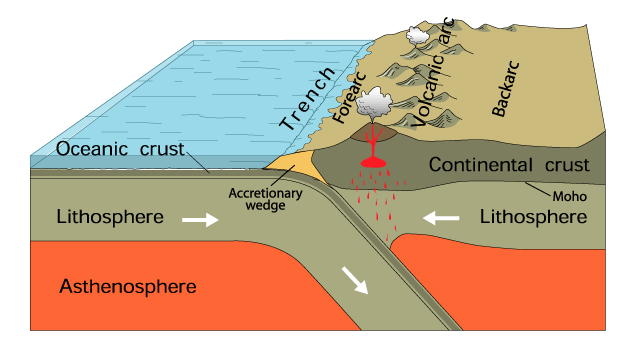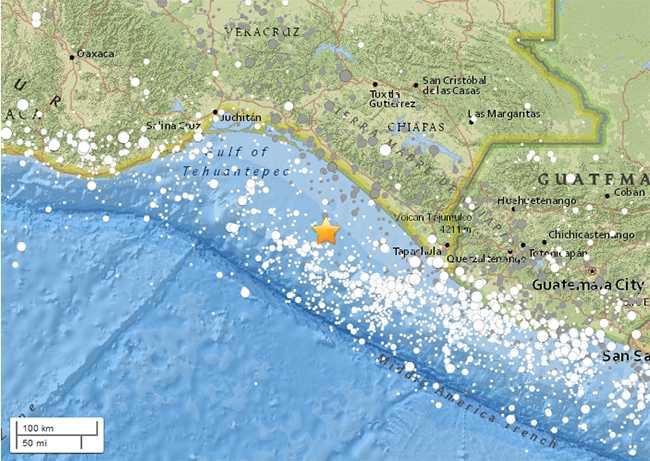8 September 2017
Big earthquake in southwestern Mexico, M8.1
Posted by Callan Bentley
An earthquake occurred overnight in southwestern Mexico, inland from the Middle America Trench, a subduction zone where the Cocos Plate (oceanic lithosphere) is being shoved down and under the North American Plate (continental lithosphere at this location). The Cocos Plate is being generated today through seafloor spreading at the East Pacific Rise, and is being “recycled” into the mantle beneath southwestern Mexico and Central America.
The quake was very powerful at magnitude 8.1, releasing lots of energy that has accumulated between the two plates as they have been shoved together over a long time. These sorts of convergent plate boundaries accumulate tremendous energy over years and years of relative motion, but the actual movement releases all that energy at once, when the strength of the rock is finally overcome, and a fault rips open (or the friction of a pre-existing fault is overcome, and it slips). (The same sort of situation happened in Japan in 2011, with even more energy released.)
The subduction zone is manifested in southwestern Mexico with a deep-sea trench where the two plates meet and a chain of volcanoes inland a ways into the overriding plate. El Chichón, Tacana, Popocatapetl, Colima, Pico de Orizaba, and Parícutin are some examples of the volcanoes that result from this subduction zone.
Here’s a general diagram showing such a setting, from the USGS. View it as if you’re looking northwestward, along the axis of the subduction zone, with the Cocos Plate on the left (southwest) and the North American Plate on the right (northeast):
The major earthquake that occurred last night was not a unique or one-off event. The area is known to have lots and lots of earthquakes over its long history of human habitation. Here are historical examples illustrated as white and gray dots:
The white dots are more shallow (less than 70 km depth), whereas the gray dots (harder to see) are deeper, greater than 70 km depth. The orange star is last night’s quake. It happened at about 71 km depth [this has been revised since I wrote the first draft of this post]. Note how the white dots parallel the trench in a linear zone, and the gray dots do the same thing, but further away from the trench: That is the signature of the subducted Cocos Plate “diving” down and to the northeast beneath Mexico, getting deeper as it makes its way along. Our new quake is right at the map key’s cut-off between “relatively shallow white dots” and “relatively deep gray dots,” and conveniently plots between the two major belts of dots on the map.
[UPDATE] Jascha Polet of Cal-Poly Pomona posted these useful diagrams on Twitter this morning, showing “beach ball” plots for many, many earthquakes in this region, and a cross-sectional plot showing the descending slab:
Seismicity cross-section of M8.2 quake: occurred in region with similar intraslab quakes, inland & at greater depth than interface thrusts pic.twitter.com/3yb47GUBIB
— Jascha Polet (@CPPGeophysics) September 8, 2017
Here, red is shallow, and blue is deep, and orange and yellow are somewhere in between. Notice how the “beach balls” look different from the side view as compared to the map view. Visualize them as spheres, sliced into four wedges apiece: two compressional (colored) and two extensional (white). With the white on “top” of last night’s quake, it looks like we have “normal” fault motion responsible for the shaking. This is a little counter-intuitive, given the larger tectonic context, but as you can see from Jascha Polet’s map, it’s pretty consistent with the historical trends in that zone. It’s a normal fault within the subducting slab.
The USGS’s PAGER program, an automated system that compares the size of a given earthquake with the local population density and state of development, estimates between a 1000 and 10,000 deaths from this quake as most likely, as well as significant economic losses (a billion to 1o billion dollars). There is a tsunami threat to Pacific nations and islands in the region: See tsunami.gov for more details.
There is no relation between this earthquake and Hurricane Katia, which is menacing the Gulf coast of Mexico at the same time. They are separate events, one driven by heat from Earth’s deep interior (the earthquake, which results from plate movement) and one driven by heat from the Sun poured onto Earth’s surface (its oceans and atmosphere: the hurricane). I know it seems like there’s a lot of natural disasters going on right now, with a trio of hurricanes in the Atlantic Basin, wildfires raging through the western part of the continent, and now this major earthquake. But though our natural tendency as humans is to look for patterns in natural observations, sometimes that tendency can lead us to draw causative connections where none really exist.
An earthquake this large changes the stresses acting on the rocks in the whole region, and aftershocks are going to happen as a result of readjustments. Expect more shaking in southwestern Mexico for the immediate future.





 Callan Bentley is Associate Professor of Geology at Piedmont Virginia Community College in Charlottesville, Virginia. He is a Fellow of the Geological Society of America. For his work on this blog, the National Association of Geoscience Teachers recognized him with the James Shea Award. He has also won the Outstanding Faculty Award from the State Council on Higher Education in Virginia, and the Biggs Award for Excellence in Geoscience Teaching from the Geoscience Education Division of the Geological Society of America. In previous years, Callan served as a contributing editor at EARTH magazine, President of the Geological Society of Washington and President the Geo2YC division of NAGT.
Callan Bentley is Associate Professor of Geology at Piedmont Virginia Community College in Charlottesville, Virginia. He is a Fellow of the Geological Society of America. For his work on this blog, the National Association of Geoscience Teachers recognized him with the James Shea Award. He has also won the Outstanding Faculty Award from the State Council on Higher Education in Virginia, and the Biggs Award for Excellence in Geoscience Teaching from the Geoscience Education Division of the Geological Society of America. In previous years, Callan served as a contributing editor at EARTH magazine, President of the Geological Society of Washington and President the Geo2YC division of NAGT.
Dear Dr Callan,
Thanks for this clear explanation.
Best regards
Dr. Bentley,
I was recently wondering about potential causality relationships between the possible nuclear weapons test in North Korea and this earthquake, I realize we are probably talking about completely different scales of energy, but could an underground hydrogen bomb explosion transfer energy through the plates?
Thanks for this informative article.
You’ve noticed a correlation, and you’ve hypothesized a causation.
Let’s think about ways to test this hypothesis.
Have there been earthquakes before?
Have there been nuclear tests before?
Has there been a correlation observed in the past?
The answers are yes, yes, and no. We’ve got a huge dataset in the past of setting off bombs much closer (and therefore more plausibly in a causative position) to Mexico: that’s a great source of information for addressing linkages such as the one you propose.
Dr. Bentley, thank you for the explanation. In regards to the Sept 7th 8.1 quake, is there any correlation to the solar bursts affecting earth this week? Thank you for clarifying! Johanna
Hi Johanna,
This is a question a lot like John’s question earlier. You’ve identified a coincidence of timing and imagined there might be a causative relationship. But again, I’d say “no” because we don’t need solar storms to get earthquakes; earthquakes occur constantly. There’s also no plausible causative linkage between the two, as fault movement is driven by Earth’s internal heat. The extra energy from the solar storms gets mostly deflected by Earth’s magnetic field, with a little bit getting funneled into the upper atmosphere in the polar regions. The hypocenter (exact spot of fault movement) of Mexico’s 8.1 quake is neither in the upper atmosphere, nor in a polar region. So I don’t think this hypothesis has accrued sufficient merit to pursue it any further. Thanks for asking, though! Posing potential causative relationships is how science advances, so long as we’re willing to give them a little thought and then discard them if they don’t pan out. 🙂
Dear Callan Bentley,
It is circulating an extrange video in Mexico, on this topic. I’m not an expert but sounds to me as a very despicable pieze of des-information.
May be you may wanted to know it
Material like this could cause catastrophic results if they become viral.
It was no posible to me to obtain the link but the autor is a fellow, supposely a science researcher by the name :Prof. Alex Backman
I thank you in advance, if tou decide to give us a hint
carlos Olguin Palacios
Can you send me a link? I find an Alex Backman on Twitter, and he “looks” disreputable w/r/t font sizes, etc. but I’d love to see the video. Hard to react to this without seeing it.
Dear Dr. Bently,
I live in Mexico City and we all saw lights in the sky during the earthquake. What is the explanation to this phenomenon?
That’s almost certainly exploding electrical transformers (electrical equipment); not something natural.
Dear sir
I have heared the term” outer trench swell “related to subduction.could you please explain the outer trench swell..
Thanks for the article